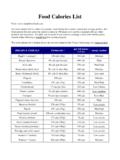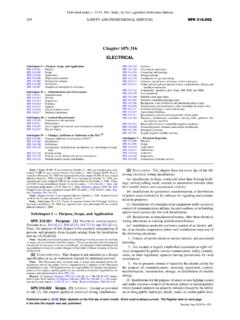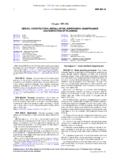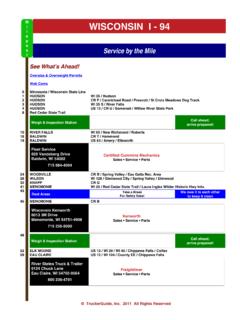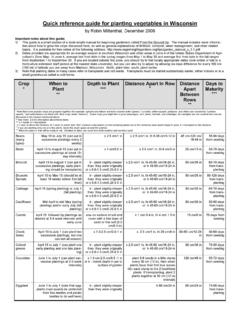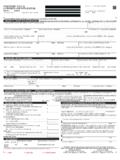Transcription of Snakes of Wisconsin by Wisconsin DNR
1 Snakes of Wisconsin by Wisconsin DNR For centuries, Snakes have been misunderstood, under-appreciated, and even heavily persecuted. However, most of us are enthralled with them and our natural curiosity seeks to better understand them. Snakes occur throughout most of the world and vary in length from 5 inches to more than 30 feet. They are closely related to lizards but do not have eyelids or ear openings. Snakes are ectothermic, relying on their surroundings to control their body temperatures. Wisconsin has 21 types of Snakes including 19 non-venemous species and 2 venomous species, four of which are endangered and one of which is threatened with extinction. Non-venomous Snakes * *There is one species (the western worm snake) that is not listed here.
2 It was officially accepted as a state species after the Snakes of Wisconsin book came out. Prairie Ringneck Snake (Diadophis punctatus arnyi) Family: Colubridae Size: 12-14 in. Status: Special Concern Distribution Map Description: A bright yellow-orange neck ring should help to identify this snake. It is distinguished from the northern ringneck by a yellow-orange belly and bright orange-red on the underside of its tail, with black half-moon spots scattered across the belly scales. Both subspecies, the prairie ringneck and northern ringneck, are colored slate blue/black on the back. Prairie ringnecks are highly secretive, spending most of the day under flat rocks along south-exposed road cuts and bluff prairies.
3 In the spring and fall, they stay on the sides of open bluffs but move to moister places in summer. Their diet includes insects, salamanders, frogs, and other small Snakes . Northern Ringneck Snake (Diadophis punctatus edwarsi) Family: Colubridae Size: 10-15 in. Status: Special Concern Distribution Map Description: This snake is similar to the prairie ringneck in size and upper appearance but has a solid light yellow belly with no markings. Unlike most Snakes , the northern ringneck makes its home in moist deciduous forests. Its diet consists of earthworms, beetles, salamanders, frogs, and other small Snakes . The northern and prairie ringneck Snakes may hybridize where their ranges overlap (see map below).
4 Where this occurs, individual specimens often have belly patterns that represent a mix of characters from each subspecies. Eastern Hognose Snake (Heterodon platirhinos) Family: Colubridae Size: 20-35 in. Status: Common Distribution Map Description: This medium-sized snake, also referred to as a "puff adder", has a sharply upturned snout, which earned this snake its name. The back has dark brown blotches on a brown-gold background color, and their underside varies from mottled yellow to mottled gray or pink. Large, older adults are usually dark brown or gray and may be patternless. Most hognose Snakes have a pair of dark black blotches on their neck that resemble eyespots when they flatten their neck.
5 Habitats include bracken grassland, oak savanna and sand prairies, but they may be seen in southern forest. Their diet consists mainly of toads but other amphibians are also eaten. Smooth Green Snake (Opheodrys vernalis) Family: Colubridae Size: 14-20 in. Status: Common Distribution Map Description: This species is often called the grass snake due to its color. The name smooth refers to the unkeeled scales which give the snake a sleek, smooth texture and appearance. This beautiful little snake is one of only five Wisconsin Snakes to have unkeeled scales. The bright emerald green color of this snake makes it easy to identify, although buff-colored individuals may be found in northern and central Wisconsin .
6 No matter the adult color, the young are olive-green upon hatching. Smooth green Snakes frequent prairies, oak savannas, bracken grasslands, open areas in pine barrens, and grassy areas along forest edges. Green Snakes feed on insects, grubs, and worms. Yellow-bellied or Blue Racer (Coluber constrictor) Family: Colubridae Size: 36-72 in. Status: Protected Wild Animal Distribution Map Description: This sleek and slender snake is among North America's fastest Snakes , traveling up to 4 mph. Adult coloration, present at about three years of age, is uniform and can vary from light to dark bluish, grayish or greenish. Hatchlings are heavily mottled with numerous dark blotches on the top and speckled with reddish-brown spots on the bottom.
7 Yellow-bellied racers prefer open dry prairies, oak savannas, and old fields where sand is the dominant soil. Their diet consists of rodents, insects, amphibians and other reptiles. Black Rat Snake or Pilot Snake (Elaphe bsoleta) Family: Colubridae Size: 40-72 in. Status: Protected Wild Animal Distribution Map Description: This long and muscular snake is Wisconsin s only arboreal (tree-dwelling) snake. Their background color is dark brown to blackish and may be flecked with white, yellow or orange between the scales. Red and yellow flecks mark the dark gray or brown underside. The heads of adults are solid black or brown on top with white chins and throats.
8 Juvenile black rat Snakes are heavily patterned and look much like young fox Snakes , although they tend to have more reddish blotches and are more slender than young fox Snakes . Black rat Snakes live in bluff prairies, oak woodlands and pastures, and are occasionally seen climbing or resting in the rafters of barns and other out buildings. Rodents and birds make up their diet. Western Fox Snake ("Pine") (Elaphe vulpina) Family: Colubridae Size: 36-56 in. Status: Common Distribution Map Description: The fox snake has many large reddish-brown, chocolate brown, or black mid-dorsal blotches along its back and other smaller blotches on its sides on a background color of yellow, tan or olive gray.
9 The head of adults is usually a dark copper, rust or orange color. They live in a variety of open habitats including marshes, sedge meadows, prairies and old fields. Their diet consists primarily of rodents and ground-nesting birds. Young fox Snakes will occasionally eat amphibians. This species is the most frequently encountered snake in people's homes, especially if the house has an old rock foundation where the snake(s) may be hunting for food or hibernating in the basement. The fox snake is often mistaken for the venomous copperhead snake due to its head color, and subsequently is often killed. Copperheads do not live in or near Wisconsin . Fox Snakes are also often mistaken for rattlesnakes, as they often 'rattle" their tails in dry leaves, grasses or against objects when disturbed.
10 Their pointed tail distinguishes them (and all other Wisconsin Snakes with pointed tails) as a non-venomous species in Wisconsin . Bullsnake (Pituophis catenifer) Family: Colubridae Size: 50-80 in. Status: Protected Wild Animal Distribution Map Description: This is Wisconsin 's longest heavy-bodied snake. Its mottled and blotched pattern changes along the length of the snake, often looking like three different Snakes connected together. The tail is usually golden with black rings. Blotches along the snake's midsection may vary from black to reddish-brown. The neck region tends to be heavily mottled with black and white. The prominent deep triangular head shape is distinctive. This harmless snake mimics a rattlesnake by shaking its tail in dry vegetation, and may hiss loudly when approached.
